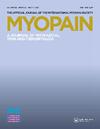Comparison of the Efficacy of Ultrasound and Extracorporeal Shock Wave Therapies in Patients with Myofascial Pain Syndrome: A Randomized Controlled Study
引用次数: 23
Abstract
Abstract Objective: Evaluation and comparison of the efficacy of ultrasound [US] and extracorporeal shock wave therapy [ESWT] in the treatment of myofascial pain syndrome. Methods: Sixty-six patients with active myofascial trigger points in the trapezius muscle were randomized into treatment groups with US and three sessions of ESWT. Efficacy of the therapies were evaluated prior to therapy at 3 weeks and at 3 months of therapy using the Patient Global Assessment and Physician’s Global Assessment scales, Neck Pain and Disability Scale, Nottingham Health Profile, and Hamilton Anxiety Scale. Results: No severe complications were encountered with US and ESWT, and patients tolerated the therapies well overall. Statistically significant improvement was determined in the number of trigger points, pain, quality of life, and anxiety scores in post-therapy evaluations [p < 0.01]. Efficacy of therapies in inter-group comparison was evaluated in terms of improvement in the same scores, and the ESWT group had greater improvement when the anxiety scores were excluded [p < 0.05]. Conclusion: Our results indicated that both US and ESWT were effective and safe treatment modalities in myofascial pain syndrome. Three sessions of low dosage ESWT was more effective compared to US therapy that could be used as an effective and safe modality in the treatment protocols of myofascial pain syndrome.超声与体外冲击波治疗肌筋膜疼痛综合征的疗效比较:一项随机对照研究
【摘要】目的:评价和比较超声与体外冲击波治疗肌筋膜疼痛综合征的疗效。方法:66例斜方肌肌筋膜触发点活跃的患者随机分为US和3次ESWT治疗组。治疗前在治疗3周和治疗3个月时使用患者总体评估和医生总体评估量表、颈部疼痛和残疾量表、诺丁汉健康概况和汉密尔顿焦虑量表评估治疗效果。结果:US和ESWT均未出现严重并发症,患者总体耐受良好。治疗后评估的触发点数量、疼痛、生活质量和焦虑评分均有统计学意义的改善[p < 0.01]。各组间比较以相同评分的改善程度评价治疗效果,排除焦虑评分后,ESWT组改善程度更大[p < 0.05]。结论:我们的研究结果表明US和ESWT都是肌筋膜疼痛综合征的有效和安全的治疗方式。与美国治疗相比,三次低剂量ESWT更有效,可以作为肌筋膜疼痛综合征治疗方案中有效和安全的方式。
本文章由计算机程序翻译,如有差异,请以英文原文为准。
求助全文
约1分钟内获得全文
求助全文

 求助内容:
求助内容: 应助结果提醒方式:
应助结果提醒方式:


